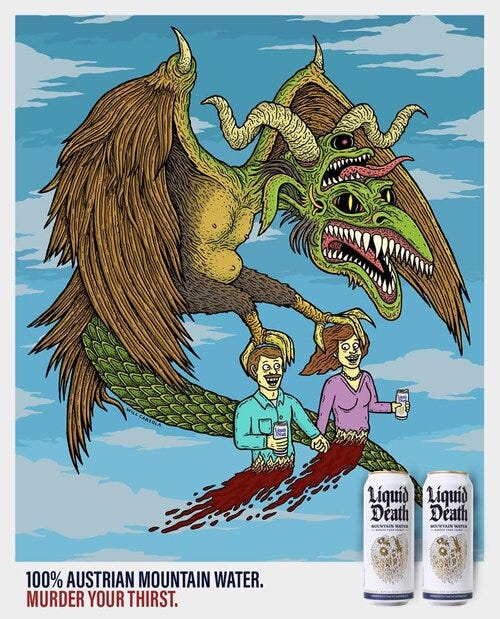Validate Before You Create: What We Can Learn from Liquid Death
How Liquid Death Proved You Don’t Need a Product to Test a Big Idea
In a world overflowing with options for water, who would have thought a brand could rise above the noise and capture attention like Liquid Death?
What started as a seemingly outrageous concept—a canned water brand that looks more like a craft beer or an energy drink—has turned into one of the most talked-about brand success stories of the past few years. Liquid Death isn’t just selling water; it’s selling rebellion, irreverence, and a sense of humor wrapped in a slick, subversive identity.
With a name that grabs attention, edgy marketing campaigns that dare to challenge the mundane, and a mission to "murder your thirst" Liquid Death has built an army of devoted fans and a brand that feels more like a movement. The company has achieved explosive growth, carving out a unique niche in a saturated market, and transforming the way we think about something as simple as water.
But behind the viral videos, punk-rock branding, and cult-like following lies a crucial lesson for startups and marketers alike: Liquid Death's success didn’t happen by chance.
✅ It all started with one crucial step - validation ✅
In marketing, we often assume the product comes first, followed by a well-planned campaign to promote it. But what if I told you that you could validate your entire product idea—before spending a dime on manufacturing?
That’s exactly what Liquid Death, the edgy canned water brand, did.
💡 The Big Idea
Founder Mike Cessario wanted to challenge the bland world of water marketing. He imagined a water brand with a punk-rock attitude—think energy drink meets beer, but it’s just... water.
Instead of pouring money into product development right away, Cessario started with an idea and one goal: to see if people would buy into the concept.
🧪 The Social Experiment
He created a bold, outrageous ad showcasing "Liquid Death" as a canned water brand with the tagline "Murder Your Thirst." The visuals screamed heavy metal; the humor was over-the-top.
There wasn’t even a product yet—just an idea wrapped in clever branding.
The ad went live on Facebook and Instagram, and the results were explosive. Thousands of people commented, liked, and shared the post, asking, “Where can I buy this?” That instant feedback validated not just the branding but the idea of a canned water product marketed as rebellious and fun.
🏴☠️ From Concept to Reality
The success of the ad gave Cessario the confidence (and the proof) to raise money and launch Liquid Death for real. What started as a social experiment turned into a global phenomenon, with the brand growing to compete with industry giants and earning a loyal cult following.
⭐️ How can you use it in your work? ⭐️
You don’t need a finished product to validate your idea—or even to test ads. Here's how you can apply this approach:
Start with a Bold Idea: What’s the “big swing” behind your product or campaign? Aim for a concept that stands out and makes people think, I need this.
Create a Minimum Viable Ad: Mock up a social ad or video that captures the essence of your idea. Focus on storytelling and emotion—make it shareable.
Launch and Listen: Run the ad on social platforms with targeting that matches your ideal audience. Watch for engagement, feedback, and interest.
Validate Before You Build: Use the insights to decide whether to pursue the idea further. If it resonates, you’ve got a head start; if not, you’ve avoided costly missteps.
Liquid Death didn’t just market a product—they marketed a vibe, a community, and a whole new way of thinking about something as simple as water. And they proved their concept before committing to it.
Hope it gave you some inspiration to validate your next big idea!
Until next time, keep growing 🚀
Idan








